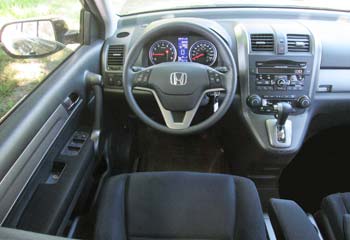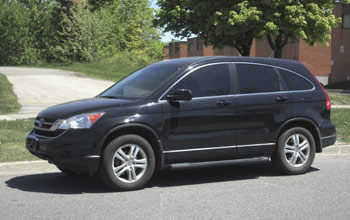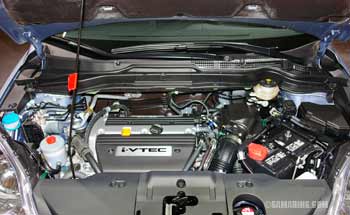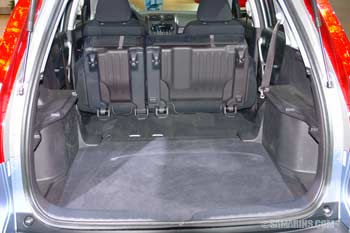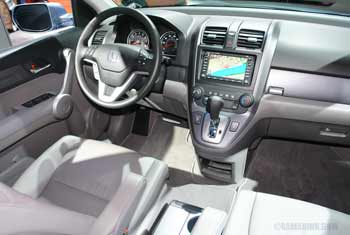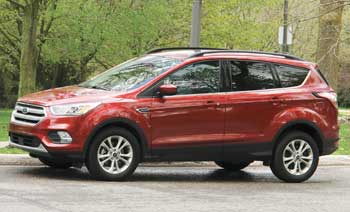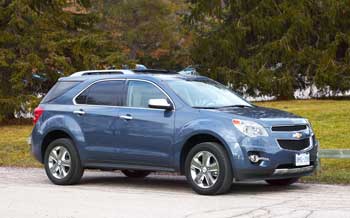Honda CR-V 2007-2011: problems, engine, pros and cons, photos
Updated: November 13, 2021
The name CR-V stands for Comfortable Runabout Vehicle, which describes this car perfectly. It's a 5-seater SUV that combines fuel economy and practicality in a well-rounded package.
Thanks to its simplicity and proven tech, it can outlast many newer SUVs with proper care. For the same reason, it holds its value well.The 2007-2011 Honda CR-V is only available with a 4-cylinder engine and a 5-speed automatic transmission. It comes as a front-wheel drive or all-wheel drive. The all-wheel drive system automatically sends power to the rear wheels when loss of traction is detected. The interior is comfortable and offers plenty of storage space. Rear seats slide back and forth and can be folded forward for extra cargo room. Is the CR-V reliable? What are the common problems?
The overall number of the NHTSA complaints is fairly small compared to other cars. Many of the complaints are related to the Takata airbag recall. The 2007-2009 CR-V had more troubles with door locks. The air conditioner is another problem area. Original tires wearing prematurely is a common issue. Some owners report longer tire life after switching to better tires (e.g. Michelin). Tire pressure (TPMS) sensors can fail. ($120-$250 to replace). Aftermarket sensors are sold online for $20-$60 each. There are quite a few reports of the excessive oil consumption, notably in the 2010-2011 CR-V. The overall reliability for the 2008-2011 CR-V is 'above average' as per Consume Reports.
Door lock actuators: The door lock actuators can fail. The service bulletin 14-083 for the 2007-2009 Honda CR-V mentions that the driver's door lock will not lock or cycles up and down when trying to unlock the door. According to the bulletin, the door lock actuator assembly must be inspected and replaced if confirmed bad. The bulletin 14-084 describes a similar problem with the other three door lock actuators. Replacing a door lock actuator will cost from $190 to $320; it's a fairly easy job. Watch these videos to see how it's replaced. Read more about the door lock actuator.
A/C Problems: Many owners reported that the A/C compressor failed and needed to be replaced. Replacing the A/C compressor will cost 2-2.6 hours of labor plus the part ($460-$890). Often, the part that fails in the A/C compressor is the electromagnetic clutch. It has an electric winding (field coil) inside that loses continuity due to corrosion. Mechanics test the A/C clutch measuring the voltage at the A/C compressor clutch connector. If the 12V is present, but the clutch does not engage, it's bad. According to the Honda technical service bulletin 12-072, the A/C compressor with a failed clutch can be repaired using the A/C Compressor Clutch Kit and the A/C Compressor Field Coil Set, which is a cheaper repair than replacing the whole compressor. Watch these videos explaining the replacement of the A/C compressor clutch.
A sticking A/C compressor clutch relay can also cause the A/C to stop working intermittently. The relay can be purchased from a Honda dealer for about $15. It is installed in the fuse box under the hood.
Advertisement
Oil consumption: The service bulletin 12-089 about the oil consumption in the 2008-2011 Honda CR-V describes the problem and repair. The deposits on the oil control rings cause them to stick in their groves. The warranty coverage for this issue had been extended for 8 years and many engines were repaired under this warranty coverage. The repair is quite expensive, see the service bulletin mentioned above. Some owners reported living with the problem and simply adding oil as it gets low. It's a good idea to check the CR-V engine oil level regularly and top up if needed.
Starter motor: A failing starter motor may cause a no-start issue. The starter motor will need to be replaced/rebuilt. Replacing a starter motor will cost 1.5 hours of labor plus the part ($130-$320 for aftermarket unit). It's also not a very difficult job; watch these videos on starter motor replacement. Read more about the starter motor and how it works.
The Check Engine light with the code P0497 could be caused by a bad purge valve (solenoid). Replacing the purge valve is easy. The part is not very expensive either. Read more about the purge valve and how it is tested.
A faulty transmission fluid pressure switch can cause the Check Engine light with codes P0843, P0842 or P0847 and possibly flashing "D" transmission indicator light. The switch part is not very expensive. Watch these videos on the repair. If the transmission fluid is dirty, it's also a good idea to change it.
Growling or groaning noise from the rear end at slow-speed turns can be caused by worn-out fluid in the rear differential. The Honda TSB recommends replacing the rear differential fluid, and burnishing the rear differential clutches.
Loose catalytic converter heat shields can cause rattles coming from under the car. The repair is not expensive.
Engine: The CR-V comes with only one engine choice: the 2.4L 4-cylinder i-VTEC, model K24. It's a proven reliable motor. With good maintenance, it can easily last for over 200K miles. One of the issues with it is that It's known to consume oil. To keep the engine in good shape, check the engine oil level regularly and top up as needed.
Does the 2007-2011 Honda CR-V have a timing belt or chain? The K24 engine has a timing chain; there is no timing belt. A timing chain doesn't need to be replaced in regular intervals.
Owner reviews: We have read hundreds of owner's reviews. Many CR-V owners list safety, comfortable and practical interior, front visibility, audio system, dashboard design and storage space among favorite features. Good fuel economy, styling, easy handling and dependability are also often mentioned. We found that many owners use their CR-Vs for long trips and camping. The most common dislike is the road noise. Many owners also commented that the OEM tires wear fast (between 15K and 25K miles). The lack of optional V6 is another frequent comment. Several owners had problems with the air conditioner that required an expensive repair, but overall, the vast majority of owner reviews are positive.
Fuel Economy: Honda CR-V is one of the most fuel-efficient SUVs with all-wheel drive. The 2011 AWD Honda CR-V is rated at 21/27 mpg (11.2/8.7 L/100km) city/highway, or up to 382 miles (615 km) to a tank.
Pros: Styling, easy handling, comfortable interior, flat floor, plenty of storage space, safety features, decent fuel economy, reliability, solid engine and transmission, used parts are widely available and not very expensive.
Cons: Road noise, firm ride, tires wear fast, thick rear pillars limit rear visibility, no center console storage.
Overall: The 2007-2011 CR-V is still one of the best SUVs among comparable models on the market. The 2007 CR-V has a few more potential problems; the 2011 is probably the best model year of this generation. Overall, it's a simple reliable vehicle and will outlast many newer modern cars with proper care. It's also easy to maintain or repair. Even if the engine will need to be replaced, it's easy to find a used engine in good shape for a reasonable price.
Similar vehicles: Ford Escape is less expensive and it's the only small SUV that still looks like a truck. It also comes with an optional V6, however, it's less reliable. The Toyota RAV4 is less roomy, but it has softer and quieter ride. The Nissan Rogue offers better city fuel economy, but the CVT transmission problems could be expensive to repair. it's also less reliable and offers less cargo space. The Subaru Outback has a more capable AWD system. The Mazda CX-7 is more sporty, but its AWD version only comes with a troublesome turbocharged engine.
Related reviews:
Honda CR-V 2002-2006
Honda CR-V 2012-2016
Honda Accord 2008-2011
Ford Escape 2008-2012
Subaru Outback 2005-2009
Toyota RAV4 2006-2012
Mazda CX-5 2013-2016
Volkswagen Tiguan 2009-2017
Subaru Outback 2010-2014
Used Ford Escape 2008-2012
Toyota RAV4 2013-2018
What to look for when buying a used Honda CR-V: The K24 engine is known to consume oil. The low oil level on the dipstick, blue smoke from the exhaust and hesitation on acceleration are all signs of excessive oil consumption. Test the A/C operation. Avoid the car if the brake pedal feels too spongy and goes down too low, as it could be an indication of a bad ABS control module which is expensive to replace. If the vehicle comes from the Salt Belt, have the undercarriage, brake lines inspected for rust damage. If the rust looks excessive, avoid the car. Check the tire condition. Are the tires of a well known brand? Are there any signs of uneven wear? See if all the door locks work. Are there any warning lights staying on on the dash? The low tire pressure warning light may indicate under-inflated tires or a bad TPMS sensor.
During a test-drive: Watch out for vibration and humming or rumbling noise (possible cupped tires or bad wheel bearing). Avoid the vehicle if the transmission slips or engages with a strong jolt. Read more: Signs of automatic transmission problems when test driving a used car. Read also: What mileage is OK for a used car?
Maintenance: Honda CR-V has Maintenance Minder system, that calculates engine oil life and other regular maintenance items based on the mileage and operating conditions. Once the required maintenance is done, the Maintenance Minder needs to be reset. The resetting procedure can be found in the owner's manual. According to the U.S. owner's manuals, for the 2007-2009 models, Honda recommends using the 5W-20 grade of oil, while for the 2010-2011 CR-V, the 0W-20 is the preferred oil grade. It's a good idea to change the transmission fluid every 60,000 miles or so to keep it clean.
